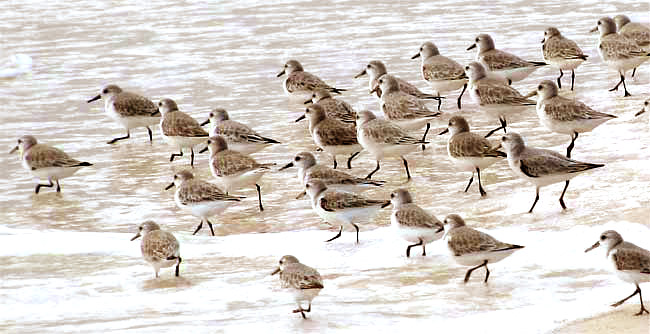Excerpts from Jim Conrad's
Naturalist Newsletter
from the December 8, 2008 Newsletter written at Mayan Beach Garden Resort 20 kms north of Mahahual; Caribbean coastal beach and mangroves, ~N18.89°, ~W87.64°, Quintana Roo state, MÉXICO
SANDERLINGS

I identified my first Sanderlings, CALADRIS ALBA, on a windy, finger-numbingly frigid February morning at Jones Beach on Long Island, New York, in 1976. I still remember the problems with my binoculars frosting up, and my frustration over being unable to definitely see any good field mark for these gray, fast-moving, nervous little birds. You can see what a hustling little flock looks like chasing a wave back to sea -- moments before they turn around to be chased by the next wave back onto the sand -- above.
Eventually I figured out their identity and what their field marks were. For one thing, their behavior is somewhat distinctive, keeping in small groups chasing waves back and forth on sandy beaches. Also, they're small and very pale gray. Finally, the thing I look for to confirm the ID is a white patch extending into the dark-gray mottling in front of their wings. In my picture the bird in the lower, right corner shows the white spot very well.
Cornell Lab of Ornithology's page on the Sanderling here describes Sanderlings as among the most widespread wintering shorebirds in the world, found on nearly all temperate and tropical sandy beaches throughout the world. Among shorebirds, only the Ruddy Turnstone and Whimbrel rival its worldwide distribution.
Howell reports Sanderlings as common winter visitors in Mexico from August to May -- all months except June and July! Sanderlings seem to live mostly in their "wintering grounds," only making brief yearly forays into the Arctic to breed.